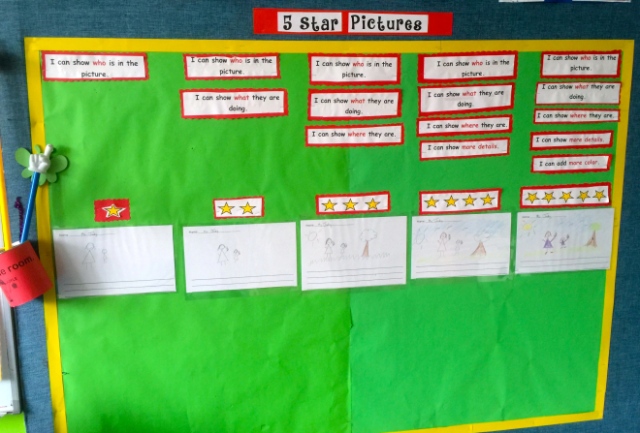#SOL: Not Your Average Homework
“We’re up to 7 now. Sophia brought in a Koala” I nudged my chin into the crook of my husband’s shoulder, destined for sleep. “7! You need a pet manager.”, he suggests. My eyes pop open. I sit up in bed.
“Yes, yes we do! That’s a brilliant idea.You’re a genius”
Let me tell you how it all began. During the summer, inspired by a former colleague of mine, I purchased a stuffed woodpecker and a fun storybook.  I introduced the book and the bird, Benny, as a home learning activity for the students, discussing the responsibility of having a classroom pet. Here’s how it has worked: one student every day was “picked” by Benny (he does this little bird call when you press him) and they would take him home, read him the story and write a bit about what they did at their home inside a writing journal.
I introduced the book and the bird, Benny, as a home learning activity for the students, discussing the responsibility of having a classroom pet. Here’s how it has worked: one student every day was “picked” by Benny (he does this little bird call when you press him) and they would take him home, read him the story and write a bit about what they did at their home inside a writing journal.  The kids loved it. They took him to restaurants. They took him to school plays. They took him to soccer matches. Benny was really enjoying himself and the kids were too. They didn’t mind writing a few sentences with their families, and the “homework” wasn’t overwhelming.
The kids loved it. They took him to restaurants. They took him to school plays. They took him to soccer matches. Benny was really enjoying himself and the kids were too. They didn’t mind writing a few sentences with their families, and the “homework” wasn’t overwhelming.
Pet #2: Then my 7-year old daughter said that she has a cat,  Cutie Pie, that probably needed to go to Grade 1 and learn more math. Cutie Pie needed some support with math story problems. Huh, I liked that idea. So I had Hannah come into Grade 1 and introduce Cutie Pie to the class. How could they not love that adorable face? Now we had a Math Cat!
Cutie Pie, that probably needed to go to Grade 1 and learn more math. Cutie Pie needed some support with math story problems. Huh, I liked that idea. So I had Hannah come into Grade 1 and introduce Cutie Pie to the class. How could they not love that adorable face? Now we had a Math Cat!
You know where this is going right? Because it was only a matter of time before a student was going to ask about bringing in another “pet”. Every time a student said they wanted to bring in another class pet, I’d ask them, “Well, what do they think they could learn from Grade 1 students?”. There is no end to their imagination. The diversity and interest of these “pets” really amaze me.
We also have a world-traveling monkey, Fruity, who loves to learn about culture and geography. And our latest addition is Joy, the Koala, loves numbers. We’re hoping that Joy can practice some expanded notation and decomposition of numbers.
Yesterday we opened up the discussion on the “pet manager” job to the kids. They loved it!–of course! So now we will have 4 students who are solely responsible for keeping track of all of these pets. I personally love that we have such a large Grade 1 family of pets and I love how the students are really showing their initiative and independence with managing them. This is definitely not your average kind of home learning and I hope in years to come, the memory of these little projects finds a home in their heart, cherishing their experience of Grade 1.
Developing learners as leaders is my joy! I am committed and passionate International Baccaluearate (IB) educator who loves cracking jokes, jumping on trampolines and reading books. When I’m not playing Minecraft with my daughter, I work on empowering others in order to create a future that works for everyone.







